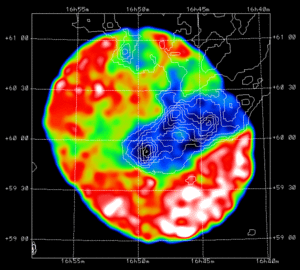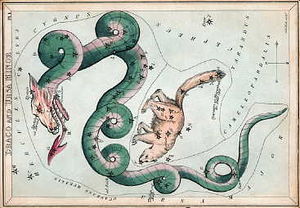Draco (constellation)
| Constellation | |
List of stars in Draco |
|
| Abbreviation | Dra |
|---|---|
| Genitive | Draconis |
| Pronunciation | /ˈdreɪkoʊ/, genitive /drəˈkoʊnɨs/ |
| Symbolism | the Dragon |
| Right ascension | 17 h |
| Declination | +65° |
| Quadrant | NQ3 |
| Area | 1083 sq. deg. (8th) |
| Main stars | 14 |
| Bayer/Flamsteed stars |
76 |
| Stars with planets | 6 |
| Stars brighter than 3.00m | 3 |
| Stars within 10.00 pc (32.62 ly) | 7 |
| Brightest star | Gamma Draconis (2.24m) |
| Nearest star | Struve 2398 (11.52 ly, 3.53 pc) |
| Messier objects | 1 |
| Meteor showers | Draconids |
| Bordering constellations |
Boötes Hercules Lyra Cygnus Cepheus Ursa Minor Camelopardalis Ursa Major |
| Visible at latitudes between +90° and −15°. Best visible at 21:00 (9 p.m.) during the month of July. |
|
Draco is a constellation in the far northern sky. Its name is Latin for dragon. Draco is circumpolar (that is, never setting) for many observers in the northern hemisphere. It was one of the 48 constellations listed by the 2nd century astronomer Ptolemy, and remains one of the 88 modern constellations today.
Contents |
Notable features
Eltanin (Gamma Draconis) is the brightest star in Draco, with an apparent magnitude of 2.24.
One of the deep-sky objects in Draco is the Cat's Eye Nebula (NGC 6543), a planetary nebula that is said to look like a blue disc. There are several faint galaxies in Draco, one of which is the lenticular galaxy NGC 5866, sometimes considered to be Messier Object 102. Another is the Draco Dwarf Galaxy, one of the least luminous galaxies with an absolute magnitude of -8.6 and a diameter of only about 3,500 light years, discovered by Albert G. Wilson of Lowell Observatory in 1954.
The star Thuban (α Draconis) was the northern pole star around 2700 BC, during the time of the ancient Egyptians. Due to the effects of precession, it will once again be the pole star around the year 21000 AD.

The Draco nebula (a soft X-ray shadow) is outlined by contours in the image at right and is blue-black. This image was produced by ROSAT of a portion of the constellation Draco.
Mythology

Draco is among the earliest of the constellations to have been defined; in one of the oldest known astronomical records, the ancient Egyptians identified it as Tawaret, the goddess of the northern sky in their pantheon of deities. Considered ever-vigilant because the constellation never set, she was depicted a fierce protective goddess whose body was a composite of crocodile, human, lioness, and hippopotamus parts.
The Greeks named it Draco the dragon. In one of the more famous European myths, Draco represents Ladon, the dragon sometimes depicted with one hundred heads who guarded the golden apples of the Hesperides. The eleventh of the Twelve Labours of Hercules was to steal the golden apples. He killed Ladon with one the arrows he dipped in the poison blood of the hydra. Hercules had no way of getting the apples even so because of the nymphs that watch over the apple tree. Atlas, the bearer of the sky, offered to get him an apple if Hercules could take his place until he returned. Hercules knew that Atlas was allowed passage because the nymphs who watched over the tree were his daughters, and agreed. Atlas came back with the apples, but he had no intention of letting Hercules walk away while he had to bear the weight of the sky on his shoulders. He was going to leave, but Hercules asked Atlas if he could hold the earth while Hercules put on his lion skin that he got from killing the Nemean Lion. Atlas stupidly agreed. Quickly, Hercules grabbed the apple from Atlas's hand, leaving Atlas holding the sky once more while Hercules completed his labor. According to the legend, Hera later placed the dragon in the sky as the constellation Draco. Due to its position and nearby constellations in the zodiac sign of Libra (i.e. Ursa Major, Ursa Minor, and Boötes), the group of constellations can be seen to tell the tale of the eleventh labor.
In another Greek legend, Draco represents the dragon killed by Cadmus before founding the city of Thebes, Greece. In a third legend, it represents the dragon that guarded the Golden Fleece (occasionally revealed as the sleeping or nearly dead figure of Ladon) and was killed by Jason. The fact that the stars of this circumpolar constellation never set plays an important part in its mythologies.
In Roman legend, Draco was a dragon killed by the goddess Minerva and tossed into the sky upon his defeat.
Early Christians originally of the Roman or Greek faith then depicted Draco as the serpent who tempted Adam and Eve in the Garden of Eden.
The Arabs did not interpret the constellation as a dragon, seeing instead an asterism called the Mother Camels.
References
- Ian Ridpath and Wil Tirion (2007). Stars and Planets Guide, Collins, London. ISBN 978-0007251209. Princeton University Press, Princeton. ISBN 978-0691135564.
External links
|
|||||
|
||||||||||||||||||||||||||||||||
|
||||||||||||||